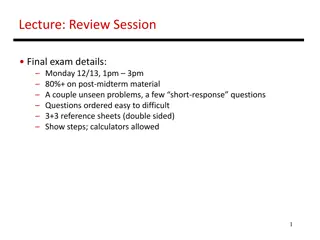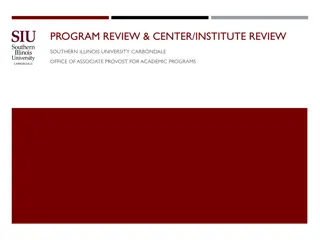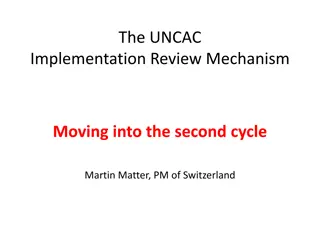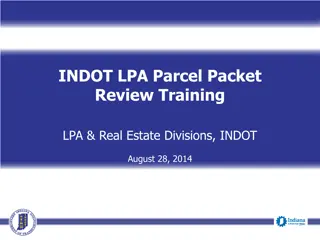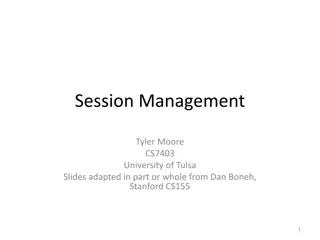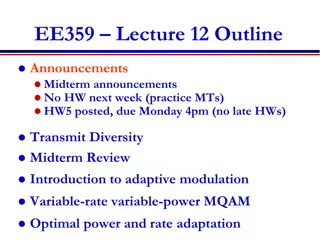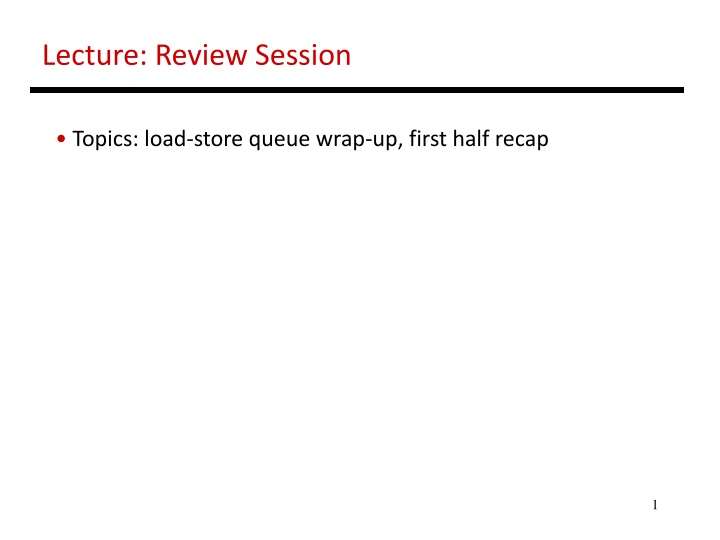
Lecture: Review Session
In this review session, we delve into the operation and timing of load-store queues, focusing on address calculation and memory accesses for each load and store operation. Through a series of problems and examples, we explore the estimation of these crucial steps without memory dependence prediction, providing insights into efficient memory management in computing systems. Dive into the details to enhance your understanding of memory handling in processor architectures.
Uploaded on | 0 Views
Download Presentation

Please find below an Image/Link to download the presentation.
The content on the website is provided AS IS for your information and personal use only. It may not be sold, licensed, or shared on other websites without obtaining consent from the author. If you encounter any issues during the download, it is possible that the publisher has removed the file from their server.
You are allowed to download the files provided on this website for personal or commercial use, subject to the condition that they are used lawfully. All files are the property of their respective owners.
The content on the website is provided AS IS for your information and personal use only. It may not be sold, licensed, or shared on other websites without obtaining consent from the author.
E N D
Presentation Transcript
Lecture: Review Session Topics: load-store queue wrap-up, first half recap 1
Problem 2 Consider the following LSQ and when operands are available. Estimate when the address calculation and memory accesses happen for each ld/st. Assume no memory dependence prediction. Ad. Op St. Op Ad.Val Ad.Cal Mem.Acc LD R1 [R2] 3 abcd LD R3 [R4] 6 adde ST R5 [R6] 4 7 abba LD R7 [R8] 2 abce ST R9 [R10] 8 3 abba LD R11 [R12] 1 abba 2
Problem 2 Consider the following LSQ and when operands are available. Estimate when the address calculation and memory accesses happen for each ld/st. Assume no memory dependence prediction. Ad. Op St. Op Ad.Val Ad.Cal Mem.Acc LD R1 [R2] 3 abcd 4 5 LD R3 [R4] 6 adde 7 8 ST R5 [R6] 4 7 abba 5 commit LD R7 [R8] 2 abce 3 6 ST R9 [R10] 8 3 abba 9 commit LD R11 [R12] 1 abba 2 10 3
Problem 3 Consider the following LSQ and when operands are available. Estimate when the address calculation and memory accesses happen for each ld/st. Assume no memory dependence prediction. Ad. Op St. Op Ad.Val Ad.Cal Mem.Acc LD R1 [R2] 3 abcd LD R3 [R4] 6 adde ST R5 [R6] 5 7 abba LD R7 [R8] 2 abce ST R9 [R10] 1 4 abba LD R11 [R12] 2 abba 4
Problem 3 Consider the following LSQ and when operands are available. Estimate when the address calculation and memory accesses happen for each ld/st. Assume no memory dependence prediction. Ad. Op St. Op Ad.Val Ad.Cal Mem.Acc LD R1 [R2] 3 abcd 4 5 LD R3 [R4] 6 adde 7 8 ST R5 [R6] 5 7 abba 6 commit LD R7 [R8] 2 abce 3 7 ST R9 [R10] 1 4 abba 2 commit LD R11 [R12] 2 abba 3 5 5
Problem 4 Consider the following LSQ and when operands are available. Estimate when the address calculation and memory accesses happen for each ld/st. Assume memory dependence prediction. Ad. Op St. Op Ad.Val Ad.Cal Mem.Acc LD R1 [R2] 3 abcd LD R3 [R4] 6 adde ST R5 [R6] 4 7 abba LD R7 [R8] 2 abce ST R9 [R10] 8 3 abba LD R11 [R12] 1 abba 6
Problem 4 Consider the following LSQ and when operands are available. Estimate when the address calculation and memory accesses happen for each ld/st. Assume memory dependence prediction. Ad. Op St. Op Ad.Val Ad.Cal Mem.Acc LD R1 [R2] 3 abcd 4 5 LD R3 [R4] 6 adde 7 8 ST R5 [R6] 4 7 abba 5 commit LD R7 [R8] 2 abce 3 4 ST R9 [R10] 8 3 abba 9 commit LD R11 [R12] 1 abba 2 3/10 7
OOO Example IQ Original code Renamed code InQ Iss Comp Comm Prev Map ADD R1, R2, R3 ADD P33, P2, P3 i i+1 i+6 i+6 P1 LD R2, 8(R1) LD P34, 8(P33) i i+2 i+8 i+8 P2 ADD R2, R2, 8 ADD P35, P34, 8 i i+4 i+9 i+9 P34 ST R1, (R3) ST P33, (P3) i i+2 i+8 i+9 SUB R1, R1, R5 SUB P36, P33, P5 i+1 i+2 i+7 i+9 P33 LD R1, 8(R2) LD P1, 8(P35) i+7 i+8 i+14 i+14 P36 ADD R1, R1, R2 ADD P2, P1, P35 i+9 i+10 i+15 i+15 P1 9
Problem 3 Processor-A at 3 GHz consumes 80 W of dynamic power and 20 W of static power. It completes a program in 20 seconds. What is the energy consumption if I scale frequency down by 20%? What is the energy consumption if I scale frequency and voltage down by 20%? 10
Problem 3 Processor-A at 3 GHz consumes 80 W of dynamic power and 20 W of static power. It completes a program in 20 seconds. What is the energy consumption if I scale frequency down by 20%? New dynamic power = 64W; New static power = 20W New execution time = 25 secs (assuming CPU-bound) Energy = 84 W x 25 secs = 2100 Joules What is the energy consumption if I scale frequency and voltage down by 20%? New dynamic power = 41W; New static power = 16W; New exec time = 25 secs; Energy = 1425 Joules 11
Problem 4 Consider 3 programs from a benchmark set. Assume that system-A is the reference machine. How does the performance of system-B compare against that of system-C (for all 3 metrics)? P1 P2 P3 Sys-A 5 10 20 Sys-B 6 8 18 Sys-C 7 9 14 Sum of execution times (AM) Sum of weighted execution times (AM) Geometric mean of execution times (GM) 12
Problem 4 Consider 3 programs from a benchmark set. Assume that system-A is the reference machine. How does the performance of system-B compare against that of system-C (for all 3 metrics)? P1 P2 P3 S.E.T S.W.E.T GM Sys-A 5 10 20 35 3 10 Sys-B 6 8 18 32 2.9 9.5 Sys-C 7 9 14 30 3 9.6 Relative to C, B provides a speedup of 1.03 (S.W.E.T) or 1.01 (GM) or 0.94 (S.E.T) Relative to C, B reduces execution time by 3.3% (S.W.E.T) or 1% (GM) or -6.7% (S.E.T) 13
Problem 6 My new laptop has a clock speed that is 30% higher than the old laptop. I m running the same binaries on both machines. Their IPCs are listed below. I run the binaries such that each binary gets an equal share of CPU time. What speedup is my new laptop providing? P1 P2 P3 Old-IPC 1.2 1.6 2.0 New-IPC 1.6 1.6 1.6 14
Problem 6 My new laptop has a clock speed that is 30% higher than the old laptop. I m running the same binaries on both machines. Their IPCs are listed below. I run the binaries such that each binary gets an equal share of CPU time. What speedup is my new laptop providing? P1 P2 P3 AM GM Old-IPC 1.2 1.6 2.0 1.6 1.57 New-IPC 1.6 1.6 1.6 1.6 1.6 AM of IPCs is the right measure. Could have also used GM. Speedup with AM would be 1.3. 15
Problem 2 An unpipelined processor takes 5 ns to work on one instruction. It then takes 0.2 ns to latch its results into latches. I was able to convert the circuits into 5 sequential pipeline stages. The stages have the following lengths: 1ns; 0.6ns; 1.2ns; 1.4ns; 0.8ns. Answer the following, assuming that there are no stalls in the pipeline. What is the cycle time in the new processor? What is the clock speed? What is the IPC? How long does it take to finish one instr? What is the speedup from pipelining? What is the max speedup from pipelining? 16
Problem 2 An unpipelined processor takes 5 ns to work on one instruction. It then takes 0.2 ns to latch its results into latches. I was able to convert the circuits into 5 sequential pipeline stages. The stages have the following lengths: 1ns; 0.6ns; 1.2ns; 1.4ns; 0.8ns. Answer the following, assuming that there are no stalls in the pipeline. What is the cycle time in the new processor? 1.6ns What is the clock speed? 625 MHz What is the IPC? 1 How long does it take to finish one instr? 8ns What is the speedup from pipelining? 625/192 = 3.26 What is the max speedup from pipelining? 5.2/0.2 = 26 17
Problem 8 Consider this 8-stage pipeline (RR and RW take a full cycle) IF DE RR AL AL DM DM RW For the following pairs of instructions, how many stalls will the 2nd instruction experience (with and without bypassing)? ADD R3 R1+R2 ADD R5 R3+R4 LD R2 [R1] ADD R4 R2+R3 LD R2 [R1] SD R3 [R2] LD R2 [R1] SD R2 [R3] 19
Problem 8 Consider this 8-stage pipeline (RR and RW take a full cycle) IF DE RR AL AL DM DM RW For the following pairs of instructions, how many stalls will the 2nd instruction experience (with and without bypassing)? ADD R3 R1+R2 ADD R5 R3+R4 without: 5 with: 1 LD R2 [R1] ADD R4 R2+R3 without: 5 with: 3 LD R2 [R1] SD R3 [R2] without: 5 with: 3 LD R2 [R1] SD R2 [R3] without: 5 with: 1 20
Problem 1 Consider a branch that is taken 80% of the time. On average, how many stalls are introduced for this branch for each approach below: Stall fetch until branch outcome is known Assume not-taken and squash if the branch is taken Assume a branch delay slot oYou can t find anything to put in the delay slot o An instr before the branch is put in the delay slot o An instr from the taken side is put in the delay slot o An instr from the not-taken side is put in the slot 21
Problem 1 Consider a branch that is taken 80% of the time. On average, how many stalls are introduced for this branch for each approach below: Stall fetch until branch outcome is known 1 Assume not-taken and squash if the branch is taken 0.8 Assume a branch delay slot oYou can t find anything to put in the delay slot 1 o An instr before the branch is put in the delay slot 0 o An instr from the taken side is put in the slot 0.2 o An instr from the not-taken side is put in the slot 0.8 22
Problem 2 Assume an unpipelined processor where it takes 5ns to go through the circuits and 0.1ns for the latch overhead. What is the throughput for 20-stage and 40-stage pipelines? Assume that the P.O.P and P.O.C in the unpipelined processor are separated by 2ns. Assume that half the instructions do not introduce a data hazard and half the instructions depend on their preceding instruction. 23
Problem 2 Assume an unpipelined processor where it takes 5ns to go through the circuits and 0.1ns for the latch overhead. What is the throughput for 1-stage, 20-stage and 50-stage pipelines? Assume that the P.O.P and P.O.C in the unpipelined processor are separated by 2ns. Assume that half the instructions do not introduce a data hazard and half the instructions depend on their preceding instruction. 1-stage: 1 instr every 5.1ns 20-stage: first instr takes 0.35ns, the second takes 2.8ns 50-stage: first instr takes 0.2ns, the second takes 4ns Throughputs: 0.20 BIPS, 0.63 BIPS, and 0.48 BIPS 24
LD -> any : 1 stall FPMUL -> any: 5 stalls FPMUL -> ST : 4 stalls IntALU -> BR : 1 stall Problem 1 for (i=1000; i>0; i--) x[i] = y[i] * s; Source code Loop: L.D F0, 0(R1) ; F0 = array element MUL.D F4, F0, F2 ; multiply scalar S.D F4, 0(R2) ; store result DADDUI R1, R1,# -8 ; decrement address pointer DADDUI R2, R2,#-8 ; decrement address pointer BNE R1, R3, Loop ; branch if R1 != R3 NOP Assembly code How many cycles do the default and optimized schedules take? 25
LD -> any : 1 stall FPMUL -> any: 5 stalls FPMUL -> ST : 4 stalls IntALU -> BR : 1 stall Problem 1 for (i=1000; i>0; i--) x[i] = y[i] * s; Source code Loop: L.D F0, 0(R1) ; F0 = array element MUL.D F4, F0, F2 ; multiply scalar S.D F4, 0(R2) ; store result DADDUI R1, R1,# -8 ; decrement address pointer DADDUI R2, R2,#-8 ; decrement address pointer BNE R1, R3, Loop ; branch if R1 != R3 NOP Assembly code Unoptimized: LD 1s MUL 4s SD DA DA BNE 1s -- 12 cycles Optimized: LD DA MUL DA 2s BNE SD -- 8 cycles Degree 2: LD LD MUL MUL DA DA 1s SD BNE SD Degree 3: LD LD LD MUL MUL MUL DA DA SD SD BNE SD 12 cyc/3 iterations 26
LD -> any : 1 stall FPMUL -> any: 5 stalls FPMUL -> ST : 4 stalls IntALU -> BR : 1 stall Problem 3 for (i=1000; i>0; i--) x[i] = y[i] * s; Source code Loop: L.D F0, 0(R1) ; F0 = array element MUL.D F4, F0, F2 ; multiply scalar S.D F4, 0(R2) ; store result DADDUI R1, R1,# -8 ; decrement address pointer DADDUI R2, R2,#-8 ; decrement address pointer BNE R1, R3, Loop ; branch if R1 != R3 NOP Assembly code How many unrolls does it take to avoid stalls in the superscalar pipeline? 28
LD -> any : 1 stall FPMUL -> any: 5 stalls FPMUL -> ST : 4 stalls IntALU -> BR : 1 stall Problem 3 for (i=1000; i>0; i--) x[i] = y[i] * s; Source code Loop: L.D F0, 0(R1) ; F0 = array element MUL.D F4, F0, F2 ; multiply scalar S.D F4, 0(R2) ; store result DADDUI R1, R1,# -8 ; decrement address pointer DADDUI R2, R2,#-8 ; decrement address pointer BNE R1, R3, Loop ; branch if R1 != R3 NOP Assembly code How many unrolls does it take to avoid stalls in the superscalar pipeline? LD LD LD MUL LD MUL LD MUL 7 unrolls. Could also make do with 5 if we LD MUL moved up the DADDUIs. LD MUL SD MUL 29
Problem 2 What is the storage requirement for a tournament predictor that uses the following structures: a selector that has 4K entries and 2-bit counters a global predictor that XORs 14 bits of branch PC with 14 bits of global history and uses 3-bit counters a local predictor that uses an 8-bit index into L1, and produces a 12-bit index into L2 by XOR-ing branch PC and local history. The L2 uses 2-bit counters. 30
Problem 2 What is the storage requirement for a tournament predictor that uses the following structures: a selector that has 4K entries and 2-bit counters a global predictor that XORs 14 bits of branch PC with 14 bits of global history and uses 3-bit counters a local predictor that uses an 8-bit index into L1, and produces a 12-bit index into L2 by XOR-ing branch PC and local history. The L2 uses 2-bit counters. Selector = 4K * 2b = 8 Kb Global = 3b * 2^14 = 48 Kb Local = (12b * 2^8) + (2b * 2^12) = 3 Kb + 8 Kb = 11 Kb Total = 67 Kb 31
Problem 3 For the code snippet below, estimate the steady-state bpred accuracies for the default PC+4 prediction, the 1-bit bimodal, 2-bit bimodal, global, and local predictors. Assume that the global/local preds use 5-bit histories. do { for (i=0; i<4; i++) { increment something } for (j=0; j<8; j++) { increment something } k++; } while (k < some large number) 32
Problem 3 For the code snippet below, estimate the steady-state bpred accuracies for the default PC+4 prediction, the 1-bit bimodal, 2-bit bimodal, global, and local predictors. Assume that the global/local preds use 5-bit histories. do { for (i=0; i<4; i++) { increment something } for (j=0; j<8; j++) { increment something } k++; } while (k < some large number) PC+4: 2/13 = 15% 1b Bim: (2+6+1)/(4+8+1) = 9/13 = 69% 2b Bim: (3+7+1)/13 = 11/13 = 85% Global: (4+7+1)/13 = 12/13 = 92% Local: (4+7+1)/13 = 12/13 = 92% 33






